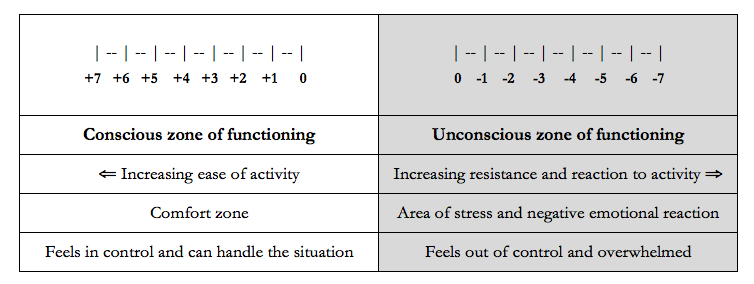By George A. Boyd © 2021
Have you ever noticed that some activities seem relatively easy to do, while others evoke reaction and resistance? It’s important to understand how this process works. We can start with a model of the psyche that graphically portrays this interplay between the conscious and unconscious zone of functioning.

0 is the transition point at the border of the Conscious/Unconscious boundary.
You experience the Conscious Zone of the mind as an area of light, where you are free to act. You experience the Unconscious Zone of the mind as an area of darkness, where you feel stress, anxiety, craving and desire, resistance, and dread.
When you are operating in the Conscious Zone of the mind, as the task becomes more difficult and challenging, you move from +7 to +1. Ease of action, even playfulness marks +7. The experience of challenge and having to operate at your maximum capacity indicates you have reached +1.
When you move to the 0 point, you reach the transition point between the Conscious Zone and the Unconscious Zone. You may feel a certain anxiety as you move across this border into operating from the Unconscious Zone.
At -1, you begin to feel stressed, like the task is getting to you and you are looking for something to lower the stress and demand upon you. At -7, you cannot function any more; you are experiencing your painful core emotions—such as suicidal depression, full panic attack, primal rage, or intense self-hatred.
The more time you spend relating and reacting from the Unconscious Zone, the greater physiological markers of stress you exhibit; the deeper you go into this layer of the mind, the greater emotional distress and misery you experience.
To expand your comfort zone, you need to engage activities that elicit a -1 response, and relax as you do engage in this activity. As you practice the activity more and it becomes easier to do, you may find that your stress response lowers and you are become willing to engage in the action without resistance or reaction. Through this means, you begin to open this area of your Conscious Zone to integrate new behavior; the Unconscious Zone yields this aspect of your behavior to the control of volition.
Methods such as Wolpe’s systematic desensitization, used in Behavioral Psychology; and mindfulness help this process of reintegration, as you are able to loosen the death grip of these reactive patterns of the unconscious and extend the zone of your conscious functioning.
In our intermediate meditation classes—the in-person Mudrashram® Master Course in Meditation and the by-mail and online Accelerated Meditation Program—we teach methods to work with material in the unconscious. These include methods like Process Meditation, the Mandala Method, and the Rainbow Technique. These methods empower you to work with unconscious material in the -1 to -5 range.
The deepest levels of core psychological pain and defensiveness at -6 and -7 are typically out of the range of effectiveness for self-help methods, such as we teach—these are deepest levels of the Unconscious Zone best addressed with professional psychotherapy—and sometimes, medication must be used to lessen the severe reactions and dysfunctional reactive behavior that arises from these deep wellsprings of the mind.
We encourage you to monitor your behavior and notice, which aspects of your behavior come out of this Unconscious Zone. When they come up, notice what you feel… notice what your thoughts and beliefs are when this arises… and notice any desire or aversion that accompanies this reaction. This will help you identify what your deep issues are—once you know what they are, you can work with them using the self-help methods you have learned, or seek professional help when these are beyond your ability to resolve using your own resources.






